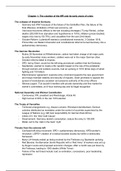Chapter 1: The creation of the WR and its early years of crisis
The collapse of Imperial Germany
- Germany lost WW1 because of the failure of the Schlieffen Plan, the failure of the
final offensive, limitations of their war economy, etc
- Vast socio-economic effects to the war including shortages (‘Turnip Winter), civilian
deaths (293,000 from starvation and hypothermia in 1918), inflation (prices doubled,
wages only rose by 50-75%), and casualties from the war (2mil dead)
- October Reform: Ludendorff wanted a constitutional monarchy. 3 October 1918,
Prince Max von Baden=chancellor and constitutional reforms=turned Germany into a
parliamentary democracy
The German Revolution
- Mutiny 29 November at Wilhelmshaven, sailors had taken charge of all major ports
by early November many workers, soldiers were est in the major German cities
- October reforms failed to impress
- SPD, led by Ebert, would be the left-wing provisional coalition that led Germany.
- Spartacists: wanted to create a SU republic based on the rule of the proletariat
through workers and soldiers councils, had an uprising in 1919 (three days of street
fighting and 100 killed)
- Ebert-Groener agreement: supreme army command supports the new government
and troops maintain stability and security of republic. Ebert promised to oppose the
spread of revolutionary socialism and preserve authority of the army officers
- Stinnes-Legien: TUs wouldn’t interfere with private ownership and free market for
worker’s committees, an 8-hour working day and full legal recognition
National Assembly and Weimar Constitution
- Controversy: PR, president and Reichstage, Article 48
- High turnout of 83% in the Jan 1919 election
The Treaty of Versailles
- Territorial arrangements e.g. Alsace-Lorraine, Rhineland demilitarised, German
colonies distributed as mandates under the control of countries supervised by the
League of Nations (e.g. GB took responsibility for German East-Africa)
- Article 231- the ‘War Guilt Clause’
- Disarmament: Germany abolish conscription, reduce the army to 100,000
- Diktat- led to the ‘stab in the back’ myth
Threats from the extreme left
- Confused left-wing movement: SPD = parliamentary democracy, KPD=worker’s
revolution, USPD= creation of a radical socialist society but within a democratic
framework
- Many LW threats ended up being crushed by the Freikorps e.g Spartacist uprising,
- Red Bavaria: the Barvarian Soviet Republic with a ‘Red Army’ of workers was set up
by Eugen Levine and proposed economic changes. After a month was put down by
the Freikorps, leading to 1000 deaths (White Terror)
- Failure of the red threat include: bad co-ordination, concessions, poor leadership,
repression






